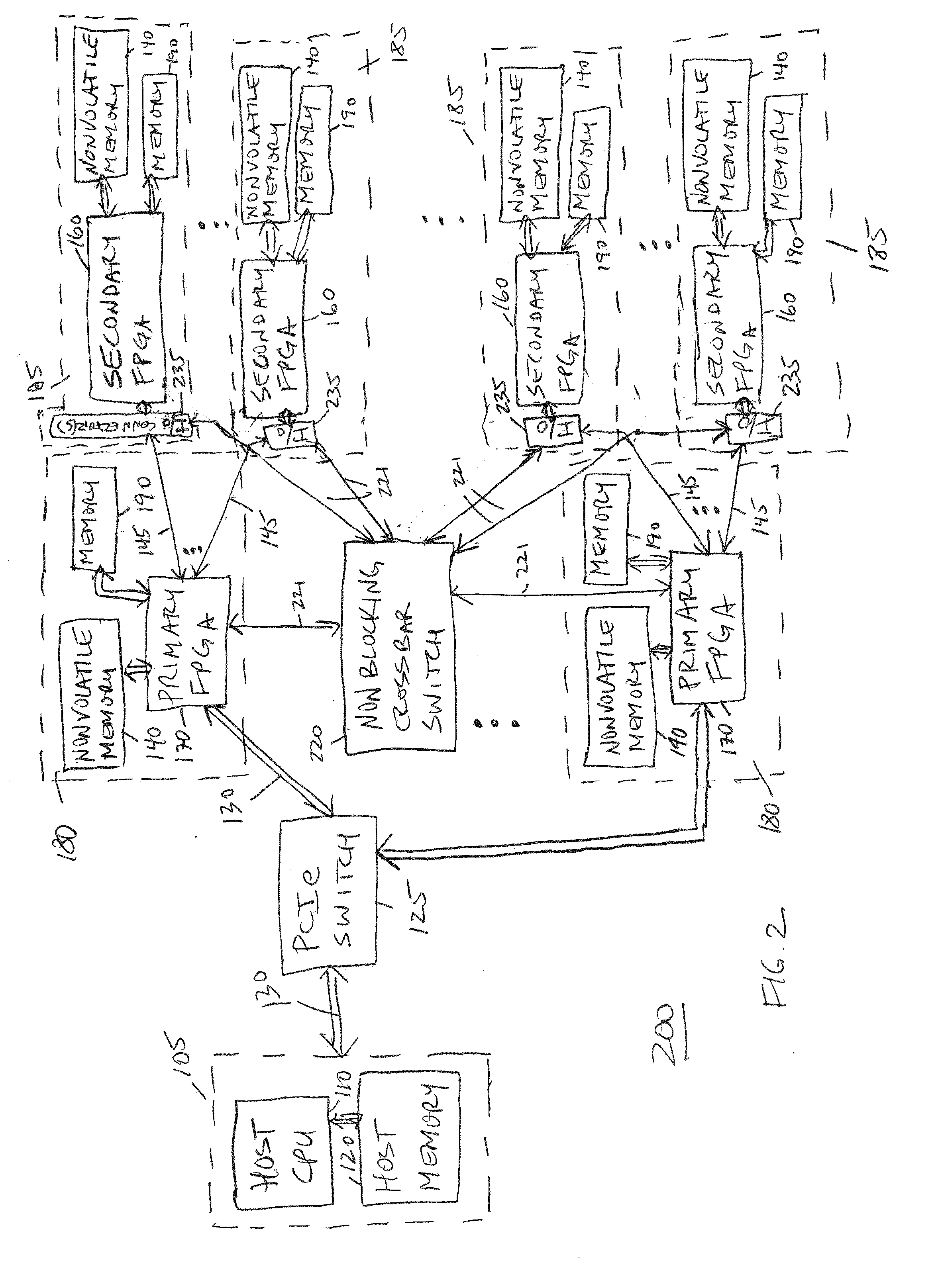Hardware Acceleration of Short Read Mapping for Genomic and Other Types of Analyses
a short read mapping and acceleration technology, applied in the field of computing systems, can solve the problems of significant speed or runtime of data analysis, challenging short read mapping problem, etc., and achieve the effects of improving speed in runtime, reducing energy consumption, and rapid genetic sequence analysis
- Summary
- Abstract
- Description
- Claims
- Application Information
AI Technical Summary
Benefits of technology
Problems solved by technology
Method used
Image
Examples
first embodiment
[0062]The one or more host computing systems 105 are typically coupled through one or more communication channels or lines, illustrated as PCI express (Peripheral Component Interconnect Express or “PCIe”) lines 130, either directly or through a PCIe switch 125, to one or more configurable logic elements such as one or more FPGAs 150 (such as a Spartan 6 FPGA or a Kintex-7 FPGA, both available from Xilinx, Inc. of San Jose, Calif., US, or a Stratix 10 or Cyclone V FPGA available from Altera Corp. of San Jose, Calif., US, for example and without limitation), each of which in turn is coupled to a nonvolatile memory 140, such as a FLASH memory (such as for storing configuration bit images), and to a plurality of random access memories 190, such as a plurality of DDR3 (SODIMM) memory integrated circuits. In a first embodiment as illustrated, each FPGA 150 and corresponding memories 140, 190 directly coupled to that FPGA 150 are collocated on a corresponding computing module (or circuit b...
embodiment 600
[0109]FIG. 12 is a system configuration block diagram illustrating an exemplary or representative accelerated short read mapping FPGA configuration embodiment 600, which may be implemented using any of the FPGAs 150, 160, 170 and memory (or memories) 190 (such as DDR3) on any of the computing modules (boards or cards) 175, 180, 185, 195, 115. More specifically, each of the various “configuration blocks” described herein are one or more configurations of an FPGA 150, 160, 170, and these one or more configurations may be loaded into the FPGA 150, 160, 170 as described above. In addition, any of the data transfers between and among the FPGAs 150, 160, 170 may be performed as described above, such as for transferring data between partitions, for example and without limitation.
[0110]The reference genome index 500, or a part or partition of the reference genome index 500 (when partitioned), has been stored in memory 190, which may be comprised of several memory ICs. In addition, the corre...
second embodiment
[0127]In a second embodiment, the affine gap model is utilized, which scores long insertion or deletion chains different from short insertions and deletions. In this model, the cost to begin an insertion or deletion chain is higher than the cost to continue an insertion or deletion chain. This model allows for longer insertion and deletion chains to appear in the actual alignment, which can be more biologically accurate. However, this model requires that we store three copies of the 2D scoring array. The first copy is the similarity score, and the other two are the current insertion and deletion scores at each cell respectively.
[0128]When using the affine gap model, the score for a cell is computed by solving (3), where α is a positive value that is the gap-open penalty, β is a positive value that is the gap-extension penalty, E(i,j) is the current read gap score for cell (i,j), F(i,j) is the current reference gap score for cell (i,j), σ(S[i], T[j]) is the positive or negative score...
PUM
| Property | Measurement | Unit |
|---|---|---|
| length | aaaaa | aaaaa |
| size | aaaaa | aaaaa |
| Speed | aaaaa | aaaaa |
Abstract
Description
Claims
Application Information
 Login to View More
Login to View More - R&D
- Intellectual Property
- Life Sciences
- Materials
- Tech Scout
- Unparalleled Data Quality
- Higher Quality Content
- 60% Fewer Hallucinations
Browse by: Latest US Patents, China's latest patents, Technical Efficacy Thesaurus, Application Domain, Technology Topic, Popular Technical Reports.
© 2025 PatSnap. All rights reserved.Legal|Privacy policy|Modern Slavery Act Transparency Statement|Sitemap|About US| Contact US: help@patsnap.com



